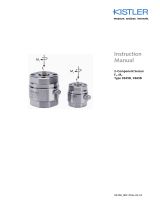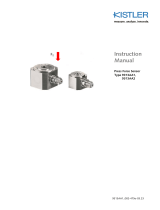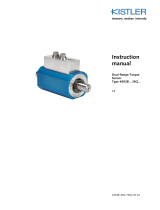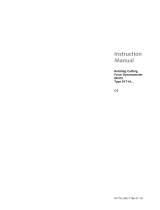Page is loading ...

System
Description
KiTorq Torque
Measuring Flange
Type 454xA...
Type 455xA...
ä
002-566e-03.23


Foreword
002-566e-03.23 Page 1
Foreword
This system description applies to the torque measuring
flange system that consists of the type 455xA... KiTorq
Rotor torque measuring unit and the type 454xA... KiTorq
Stator torque evaluation unit.
Keep this system description for future reference. It should
be available at the point of use.
Information in this system description is subject to change
at any time, without notice. Kistler reserves the right to
improve and modify its products in the course of technical
advancement, without any obligation to inform any
persons or organizations of such changes.
Original language of this System description: German
©2011 … 2023 Kistler Group. All rights reserved.
Kistler Group
Eulachstrasse 22
8408 Winterthur
Switzerland
phone +41 52 224 11 11
www.kistler.com

KiTorq Torque Measuring Flange, Type 455xA...
002-566e-03.23 Page 2
Contents
1.Introduction ................................................................................................................................... 7
1.1FCC compliance statement ................................................................................................... 8
2.General description of the KiTorq System ...................................................................................... 9
2.1KiTorq stator torque evaluation unit ..................................................................................... 9
2.2KiTorq rotor torque measuring unit ...................................................................................... 9
3.Transmission ................................................................................................................................ 10
4.Speed/Angle measurement .......................................................................................................... 11
4.1Speed measuring system for Type 4550A… ....................................................................... 11
4.2Speed measuring system for Type 4551A… ....................................................................... 11
4.3Diagram – Maximum possible output pulses ...................................................................... 12
5.Terminology Calibration .............................................................................................................. 13
5.1Terminology ....................................................................................................................... 13
6.Typical setup of a KiTorq torque measuring linkage .................................................................... 15
7.Vibrations .................................................................................................................................... 16
8.Evaluation of the torque ............................................................................................................... 17
9.Running the measurement cable .................................................................................................. 18
9.1Connection diagram torque measuring flange .................................................................... 19
10.Standard calibration and special calibration ................................................................................. 20
11.Important notes Type 455xA… .................................................................................................... 21
11.1For your safety ................................................................................................................... 21
11.2Electromagnetic compatibility (EMC) .................................................................................. 21
11.3Tips for using this assembly manual ................................................................................... 22
11.4Note on the disposal of electronic devices .......................................................................... 22
12.Typical properties torque measuring unit .................................................................................... 22
13.Brief instructions for commissioning Type 455xA… .................................................................... 23
13.1Mechanical setup ............................................................................................................... 23
13.1.1Mounting the torque measuring unit on the counterflange ................................... 24
13.1.2Rotor screw connection/mounting screws Type 4550A… ..................................... 24
13.1.3Rotor screw connection/mounting screws Type 4551A… ..................................... 24
13.1.4Alignment of the Type 455xA... torque measuring unit (Rotor and Stator) ............ 25
13.1.5Application examples ............................................................................................. 26
13.2Metal-free space ................................................................................................................ 26
14.Standard calibration and special calibration ................................................................................. 27

Introduction
Page 3 002-566e-03.23
15.Important notes Type 454xA… ..................................................................................................... 28
15.1For your safety .................................................................................................................... 28
15.2Electromagnetic compatibility (EMC) .................................................................................. 28
15.3Tips for using the instruction manual .................................................................................. 28
15.4Note on the disposal of electronic devices ........................................................................... 29
16.Typical properties of the torque evaluation unit ........................................................................... 30
16.1Functional overview Type 4541A… .................................................................................... 30
16.2Functional overview Type 4542A… .................................................................................... 30
16.3Overview of signal processing Type 4541A… ..................................................................... 31
16.4Overview of signal processing Type 4542A… ..................................................................... 31
17.Assembly manual and alignment .................................................................................................. 32
17.1Mounting ............................................................................................................................ 34
18.Plug connections Type 4541A… ................................................................................................... 35
18.1Connector X1: 7 Pin built-in connector Type 4541A… ....................................................... 35
18.2Connector X2: 14 Pin built-in connector Type 4541A… ..................................................... 35
18.3Connector X3: 7 Pin built-in connector Type 4541A… ....................................................... 36
18.4Connector X4: 12 Pin built-in connector Type 4541A… ..................................................... 36
18.5Connector X1, X2 (PROFINET, EtherCAT, EtherNet/IP) Type 4542A… .............................. 37
18.6Connector X1 and X2 (PROFIBUS) Type 4542A… .............................................................. 38
18.7Connector X1 and X2 (CANopen) Type 4542A… ............................................................... 39
18.8Connector X3 Type 4542A… .............................................................................................. 40
18.9Connector X4 Type 4542A… .............................................................................................. 41
18.9.1Connector X4: 12 Pin built-in connector Type 4542A…......................................... 41
18.10Connector X5: USB Type 454xA… ...................................................................................... 42
18.11USB Interface Type 454xA… .............................................................................................. 42
18.12Tare button Type 454xA… ................................................................................................. 43
18.13Power LED Type 454xA… .................................................................................................. 43
18.14Communication LEDs PROFINET Type 4542A… ................................................................ 44
18.15Communication LEDs EtherCAT Type 4542A… .................................................................. 45
18.16Communication LEDs EtherNet/IP Type 4542A… ............................................................... 47
18.17Communication LEDs PROFIBUS Type 4542A… ................................................................ 48
18.18Communication LEDs CANopen Type 4542A… .................................................................. 49
19.Connection cable Type 4541A… .................................................................................................. 50
20.Connection cable Type 4542A… .................................................................................................. 52
21.Further connection cable Type 4542A… ....................................................................................... 55
22.Electrical and mechanical commissioning Type 454xA… ............................................................. 57
23.Calibration .................................................................................................................................... 59
23.1Torque evaluation unit (Stator) ........................................................................................... 59
23.2Generating the system certificate from the individual certificates ........................................ 59
24.Features ........................................................................................................................................ 61
24.1Tips for using these operating instructions .......................................................................... 61
24.2Nomenclature ..................................................................................................................... 61
25.Interface commands ...................................................................................................................... 62

KiTorq Torque Measuring Flange, Type 455xA...
002-566e-03.23 Page 4
25.1Conventions and syntax ..................................................................................................... 62
25.2Glossary of commands ....................................................................................................... 64
25.3Error messages ................................................................................................................... 67
25.4HyperTerminal® .................................................................................................................. 68
25.5System ............................................................................................................................... 72
25.5.1Identification (*IDN?) ............................................................................................ 72
25.5.2Event status register (*ESR?) ................................................................................. 73
25.6Measure ............................................................................................................................. 75
25.6.1Determine measured values (MEAS) ...................................................................... 75
25.6.2Clear peak value buffer (TRAC) ............................................................................. 76
25.6.3Switch scaling range (INP:GAIN:MULT) ................................................................ 77
25.6.4Control signal (INP:CONT) .................................................................................... 77
25.6.5Low pass filter for digital measured torque values (OUTP:TORQ:FILT) ................. 78
25.6.6Low pass filter for digital measured torque values measured speed values
(OUTP:SPE:FILT) ................................................................................................... 79
25.6.7Tare the torque outputs (OUTP:TARE) .................................................................. 80
25.6.8Tare the angle output signal (TRAC:ANG) ............................................................. 81
25.6.9Automatic tare of angle output signal (SYST:SPE:TURN) ....................................... 81
25.6.10Number of output pulses (OUTP:SPE:IMP) ............................................................ 81
25.6.11Synchronize measured values (INP:SYNC) ............................................................. 82
25.6.12Absolute/Relative angle measurement (SYST:SPE:MODE) ..................................... 82
25.7Primary voltage output (Plug X3) ...................................................................................... 83
25.7.1Configuration (OUTP:PRI:VOLT:CONF) ................................................................ 83
25.7.2Source (OUTP:PRI:VOLT:SOUR) ........................................................................... 84
25.7.3Scaling ranges (OUTP:PRI:VOLT[:EXT]:SCAL) ....................................................... 84
25.7.4Low-Pass filter (OUTP:PRI:VOLT[:EXT]:FILT) ........................................................ 85
25.7.5Taring (OUTP:PRI:VOLT:TARE) ............................................................................. 86
25.7.6Output swing magnitude (OUTP:PRI:VOLT:MAGN) ............................................. 87
25.7.7Output swing magnitude for control (OUTP:PRI:VOLT:CONT:MAGN) ................ 87
25.7.8Digital control input (INP:PRI:VOLT:CONT) .......................................................... 88
25.8Primary frequency output (plug X1) Type 4541A… ........................................................... 89
25.8.1Configuration (OUTP:PRI:FREQ:CONF) Type 4541A… ........................................ 89
25.8.2Scaling ranges (OUTP:PRI:FREQ[:EXT]:SCAL) Type 4541A… ................................ 90
25.8.3Low-Pass filter (OUTP:PRI:FREQ[:EXT]:FILT) Type 4541A… ................................. 90
25.8.4Taring (OUTP:PRI:FREQ:TARE) Type 4541A… ..................................................... 92
25.8.5Output zero point (OUTP:PRI:FREQ:ZERO) Type 4541A… .................................. 93
25.8.6Output swing magnitude (OUTP:PRI:FREQ:MAGN) Type 4541A… ..................... 93
25.8.7Output swing magnitude for control (OUTP:PRI:FREQ:CONT:MAGN) Type
4541A… ............................................................................................................... 94
25.8.8Output signal shape (OUTP:FREQ:MODE) Type 4541A… .................................... 94
25.8.9Output amplitude (OUTP:FREQ:AMPL) Type 4541A… ........................................ 95
25.8.10Digital control input (INP:PRI:FREQ:CONT) Type 4541A… ................................... 95
25.9Secondary output (Plug X4) ............................................................................................... 96
25.9.1Configuration (OUTP:SEC:CONF) ......................................................................... 96
25.9.2Source (OUTP:SEC:SOUR) .................................................................................... 97
25.9.3Output signal type (OUTP:SEC:ROUT) ................................................................. 97
25.9.4Scaling ranges (OUTP:SEC[:EXT]:SCAL) ................................................................ 98
25.9.5Low-pass filter (OUTP:SEC[:EXT]:FILT) .................................................................. 99
25.9.6Taring (OUTP:SEC:TARE) .................................................................................... 100
25.9.7Output voltage swing magnitude (OUTP:SEC:VOLT:MAGN) ............................. 101
25.9.8Output Voltage Swing Magnitude for Control (OUTP:SEC:VOLT:CONT:MAGN) 101
25.9.9Frequency output zero point (OUTP:SEC:FREQ:ZERO) ....................................... 102
25.9.10Output frequency swing magnitude (OUTP:SEC:FREQ:MAGN) .......................... 102
25.9.11Output frequency swing magnitude for control (OUTP:SEC:FREQ…) ................. 103
25.9.12Output amplitude (OUTP:FREQ:AMPL) .............................................................. 103
25.9.13Digital control input (INP:SEC:CONT) ................................................................. 104

Introduction
Page 5 002-566e-03.23
25.10Peripheral output (plug X2) Type 4541A… ....................................................................... 104
25.10.1Digital control input (INP:PRI:FREQ:CONT) ......................................................... 104
25.10.2Digital tare input (INP:TARP) Type 4541A… ........................................................ 105
25.10.3Digital scaling selection (INP:RANG) Type 4541A… ............................................. 106
25.10.4Digital scaling acknowledgment (OUTP:RANG:ACKN) Type 4541A… ................. 106
25.11Tare button and LED ......................................................................................................... 107
25.11.1State of the Tare Button (INP:TARB) .................................................................... 107
25.11.2State of the LED (OUTP:LED) ............................................................................... 107
25.12Fieldbus/Industrial Ethernet (general data) Type 4542A… ................................................ 108
25.12.1Fieldbus/Industrial Ethernet Type (OUTP:FBUS:TYPE) Type 4542A… .................. 108
25.12.2Physical plug type (OUTP:FBUS:HARD) Type 4542A… ....................................... 108
25.12.3Firmware version (OUTP:FBUS:VER) Type 4542A… ............................................ 109
25.13PROFINET Type 4542A… ................................................................................................. 109
25.13.1MAC address (OUTP:FBUS:PN:MAC) .................................................................. 109
25.13.2Device name (OUTP:FBUS:PN:NAME) Type 4542A… ......................................... 110
25.13.3IP address (OUTP:FBUS:PN:[IP | ADDR]) Type 4542A… ...................................... 110
25.13.4Subnet mask (OUTP:FBUS:PN:GATE) Type 4542A… ........................................... 111
25.13.5Gateway address (OUTP:FBUS:PN:GATE) Type 4542A… .................................... 111
25.13.6Define IP address (OUTP:FBUS:PN:[IP | ADDR]:PWUP) Type 4542A… ............... 111
25.13.7Define device name (OUTP:FBUS:PN:NAME:PWUP) Typ 4542A… ..................... 112
25.13.8Define subnet mask (OUTP:FBUS:PN:SUBN:PWUP) Type 4542A… .................... 113
25.13.9Define gateway address (OUTP:FBUS:PN:GATE:PWUP) Type 4542A… .............. 113
25.14PROFIBUS Type 4542A… ................................................................................................. 115
25.14.1Address (OUTP:FBUS:PB:ADDR) Type 4542A… .................................................. 115
25.14.2Baud rate (OUTP:FBUS:PB:BAUD) Type 4542A… ................................................ 115
25.15CANopen Type 4542A… .................................................................................................. 117
25.15.1ID (OUTP:FBUS:CAN:ID) Type 4542A… ............................................................. 117
25.15.2Baud rate (OUTP:FBUS:CAN:BAUD) Type 4542A… ............................................ 117
25.15.3TPDO refresh rate (OUTP:FBUS:CAN:PDO:RATE) Type 4542A… ....................... 118
25.15.4Status (OUTP:FBUS:CAN:MODE) Type 4542A… ................................................ 118
25.15.5Switch TPDO On and Off (OUTP:FBUS:CAN:TPDO) Type 4542A… ................... 119
25.16EtherCAT Type 4542A… .................................................................................................. 120
25.16.1MAC address (OUTP:FBUS:ECAT:MAC) Type 4542A… ...................................... 120
25.16.2Second station address (OUTP:FBUS:ECAT:SSAD) ............................................... 120
25.17EtherNet/IP Type 4542A… ............................................................................................... 121
25.17.1MAC address (OUTP:FBUS:EIP:MAC) Type 4542A… .......................................... 121
25.17.2IP address (OUTP:FBUS:EIP:[IP | ADDR]) Type 4542A… ...................................... 121
25.17.3Subnet mask (OUTP:FBUS:EIP:GATE) Type 4542A… ........................................... 122
25.17.4Gateway address (OUTP:FBUS:EIP:GATE) Type 4542A… .................................... 122
25.17.5Define IP address (OUTP:FBUS:EIP:[IP | ADDR]:PWUP) Type 4542A… ............... 122
25.17.6Define subnet mask (OUTP:FBUS:EIP:SUBN:PWUP) Type 4542A… .................... 123
25.17.7Define gateway address (OUTP:FBUS:EIP:GATE:PWUP) Type 4542A… .............. 124
25.18Buffer area ........................................................................................................................ 125
25.18.1Load and save settings (MEM:[LOAD | SAVE]) .................................................... 125
25.18.2Digital data sheet ................................................................................................. 126
26.PROFINET Type 4542A… ........................................................................................................... 128
26.1Cyclical input data (for sensor) Type 4542A… .................................................................. 128
26.2Cyclical output data (from sensor) Type 4542A… ............................................................. 131
26.2.1Status bytes Type 4542A… .................................................................................. 132
26.2.2Torque and measured value status Type 4542A… ............................................... 132
26.2.3Speed and measured value status Type 4542A… ................................................. 133
26.2.4Angle and measured value status Type 4542A… ................................................. 134
26.2.5Rotor temperature and measured value Type 4542A…........................................ 135
26.2.6GSDML-file Type 4542A… .................................................................................. 135

KiTorq Torque Measuring Flange, Type 455xA...
002-566e-03.23 Page 6
27.PROFIBUS Type 4542A… .......................................................................................................... 136
27.1Cyclical input data (for sensor) Type 4542A… ................................................................. 136
27.2Cyclical output data (from sensor) Type 4542A… ............................................................ 139
27.2.1Status bytes Type 4542A… ................................................................................. 140
27.2.2Torque and measured value status Type 4542A… .............................................. 140
27.2.3Speed and measured value status Type 4542A… ................................................ 141
27.2.4Angle and measured value status Type 4542A… ................................................ 142
27.2.5Rotor temperature and measured value status Type 4542A… ............................. 143
27.2.6GSD file Type 4542A… ....................................................................................... 143
28.CANopen Type 4542A… ............................................................................................................ 144
28.1Cyclical input data RPDO 1 (for sensor) Type 4542A… ................................................... 144
28.2Cyclical output data TPDOs (from sensor) Type 4542A… ................................................ 147
28.2.1TPDO 1 Torque Type 4542A… ........................................................................... 147
28.2.2TPDO 2 speed Type 4542A… ............................................................................. 149
28.2.3TPDO 3 Rotor temperature Type 4542A… ......................................................... 150
28.2.4TPDO 4 angle Type 4542A… .............................................................................. 151
28.2.5EDS File Type 4542A… ....................................................................................... 152
29.EtherCAT Type 4542A… ............................................................................................................ 153
29.1Cyclical input data (for sensor) Type 4542A… ................................................................. 153
29.2Cyclical output data (from sensor) Type 4542A… ............................................................ 156
29.2.1Status bytes Type 4542A… ................................................................................. 157
29.2.2Torque and measured value status Type 4542A… .............................................. 157
29.2.3Speed and measured value status Type 4542A… ................................................ 158
29.2.4Angle and measured value status Type 4542A… ................................................ 159
29.2.5Rotor temperature and measured value status Type 4542A… ............................ 160
29.2.6XML file Type 4542A… ....................................................................................... 160
30.Ethernet/IP Type 4542A… ......................................................................................................... 161
30.1Cyclical input data (for sensor) Type 4542A… ................................................................. 161
30.2Cyclical output data (from sensor) Type 4542A… ............................................................ 164
30.2.1Status bytes Type 4542A… ................................................................................. 165
30.2.2Torque and measured value status Type 4542A… .............................................. 165
30.2.3Speed and measured value status Type 4542A… ................................................ 166
30.2.4Angle and measured value status Type 4542A… ................................................ 167
30.2.5Rotor temperature and measured value status Type 4542A… ............................. 168
30.2.6EDS file Type 4542A… ........................................................................................ 168
31.Index .......................................................................................................................................... 169
Total pages 171

Introduction
Page 7 002-566e-03.23
1. Introduction
Thank you for choosing a quality product from Kistler.
Please read this system description carefully, so that you
can put the many properties of your product to optimal
use.
Kistler declines any liability, to the extent permissible by
law, if action is taken contrary to this system description, or
other products are used than those listed as accessories.
Kistler provides a wide range of metrology products and
overall solutions:
Piezoelectric sensors for measuring pressure, force, torque,
strain, acceleration, shock, and vibration
Strain gage sensor systems for measuring force and torque
Piezoresistive pressure sensors and transmitters, with
corresponding measuring amplifiers
Corresponding measuring amplifiers (charge amplifiers,
piezoresistive amplifiers, etc.), display units, and charge
calibrators
Electronic control, monitoring, and evaluation units, and
application-specific metrological software
Data transmission modules (telemetry)
Electromechanical NC joining modules and load-
displacement monitors
Test bench systems for electric motors and gears in the lab,
in production, and for quality assurance
Kistler also develops concepts for entire measurement
systems for special uses, such as in the automotive
industry, plastic processing, and biomechanics.
Our full catalog provides an overview of our product line.
Detailed data sheets area available for practically all of our
products.
For assistance with any special questions remaining after
studying these instructions, Kistler customer service is
available around the world with expert advice for
application-specific problems.

KiTorq Torque Measuring Flange, Type 455xA...
002-566e-03.23 Page 8
1.1 FCC compliance statement
This device complies with Industry Canada licence-exempt
RSS standard(s) and part 15 of the FCC Rules. Operation is
subject to the following two conditions:
(1) this device may not cause interference, and (2) this
device must accept any interference, including interference
that may cause undesired operation of the device.
Changes or modifications not expressly approved by the
party responsible for compliance could void the user's
authority to operate the equipment.

General description of the KiTorq System
Page 9 002-566e-03.23
2. General description of the KiTorq System
The torque measuring flange consists of a KiTorq Rotor
torque measuring unit, a KiTorq Stator torque evaluation
unit, and a calibration of the combined torque measuring
linkage. All rotors and stators in the KiTorq system are
based on the same technology, so they can be combined
with the same speed measuring option. The members of
the this technological family can be recognized by their
type identification. The torque measuring units are
identified by the type range from Type 4550A… to Type
4559A…, and the torque evaluation units are found in the
range from Type 4541A… to Type 4549A… .
2.1 KiTorq stator torque evaluation unit
The torque evaluation unit (stator) supplies power to the
torque measuring unit (rotor), and receives data and
measured values. The digital measured values are
processed and prepared for various outputs. Depending on
the design of the evaluation unit, various types of outputs
are available.
Depending to the speed option (N1/N2/N3), the torque
evaluation unit additionally offers an integrated
speed/angle measurement system for a speed
≤20 000 min-1. Speed respectively angle can be transfered,
together with a reference pulse (Z-Impulse), as TTL signal
or read out from the serial interface.
2.2 KiTorq rotor torque measuring unit
The torque to be measured is captured by the torque
measuring unit, using strain gages, then amplified and
digitized. Due to this basic technology, all rotors in the
torque measuring flange system have a very high
bandwidth.
Tor
q
ue evaluation uni
t
KiTorq Stator
Type 454x…
Tor
q
ue measuring uni
t
KiTorq Rotor
Type 455xA…

KiTorq Torque Measuring Flange, Type 455xA...
002-566e-03.23 Page 10
Strain
Gage
V
ADC
CPLD
EEPROM
ADC
DDS
DAC
FPGA
µC
DC
DC
Torque evaluation unit
KiTorq Stator Type 454x...
Torque measuring unit
KiTorq Rotor Type 455x…
Voltage
Supply
Frequency
RS-232C
USB
Control Signal
Feldbus
DATA
POWER
3. Transmission
Transmission of power and data from the torque
evaluation unit to the torque measuring unit takes place via
inductive coupling (telemetry), across an air gap of ≤2 mm.
Frequencies from the ISM band between 115 … 130 kHz
are used for this purpose.
The torque evaluation unit automatically adapts the power
supply during operation to the axial and radial position of
the torque measuring unit, thereby securing it for all
operating points.
The feed frequency is PSK modulated for sending data to
the rotor. Depending on the feed frequency, the data rate
can be between 360 ... 406 bit/s.
The ISM band frequency 13,56 MHz is used for receiving
the measurement data. The measurement data are also
transmitted from the torque measuring unit to the torque
evaluation unit via inductive coupling as a PSK modulated
signal, at up to 1,4 MBit/s. In addition to the torque, the
rotor measurement data include the temperature, supply
voltage, and EEPROM (electrically erasable programmable
read-only memory) contents.
Fig. 1: Block diagram of a torque measuring flange

Speed/Angle measurement
Page 11 002-566e-03.23
4. Speed/Angle measurement
4.1 Speed measuring system for Type 4550A…
4.2 Speed measuring system for Type 4551A…

KiTorq Torque Measuring Flange, Type 455xA...
002-566e-03.23 Page 12
4.3 Diagram – Maximum possible output pulses

Terminology Calibration
Page 13 002-566e-03.23
5. Terminology Calibration
5.1 Terminology
There is a fundamental difference between adjusting and
calibrating. Calibration is only the measurement of
a system. The output signal that arises for defined loads is
registered. For adjustment, the output is affected by an
adjusting element while under a defined load. The torque
measuring flange is adjusted at the factory.
When a torque measuring flange is ordered for the KiTorq
system, the calibration of one or more outputs can be
selected. In this case, the torque measuring unit provided is
calibrated together with the supplied torque evaluation
unit. An individual certificate is also included for each stator
and rotor. This means that the torque measuring flange
can also be combined from individual orders for torque
measuring units (rotors) and torque evaluation units
(stators) and commissioned accordingly, and that
a component that fails during operation can be replaced
directly, without removing and recalibrating the entire
torque measuring linkage. The measurement uncertainty
and the certificate of the torque measuring flange are
derived, in this case, from a measurement uncertainty
analysis or calculation from the individual certificates for
the rotor and stator.
If the frequency output or a digital output is used for
evaluating the torque, then the calibration of the stator is
not required.
Kistler recommends regular calibration of the measurement
linkage and the individual components of the torque
measuring flange. To this end, there is a sticker on each
torque measuring unit and torque evaluation unit that
shows the next recommended calibration date. The next
calibration date can also be found on the certificate of the
torque measuring linkage.

KiTorq Torque Measuring Flange, Type 455xA...
002-566e-03.23 Page 14
The following illustration shows a simply setup for
a calibration system. Local gravity must be considered in
order to calculate the torque.
It is recommended that the calibration be performed by the
Kistler DAkkS laboratory. Available calibration types include
simple calibration, factory calibration (20 % load steps),
and DAkkS calibration per 51309 (3 mounting positions).
Further information about Kistler calibration services is
available in our Calibration brochure 960-077.
Tor
q
ue measuring flange,
such as Type 454xA...
KiTorq Stator and Type
4550A... KiTorq Rotor
Bearing for lever arm
(double bearing)
Extendable cou
p
ling
or articulated shaft
Lever arm
bearing
Locking
device
Lever arm
Weigh
t
(calibrated)
Drive
Lever arm

Typical setup of a KiTorq torque measuring linkage
Page 15 002-566e-03.23
6. Typical setup of a KiTorq torque measuring linkage
The illustration shows a typical setup of a measuring
linkage for determining torque. The torque acting on the
torque measuring flange is converted to a voltage or
a frequency. The torque measuring flange has a limit
frequency, which can be between 0,1 Hz and 10 kHz,
depending on its setting. In order to avoid aliasing effects,
a low-pass filter must be used prior to digitization. The limit
frequency of this filter must be selected depending on the
selected low-pass filter for the torque measuring flange
and the scanning frequency of the digitization.
The scanning rate must be at least twice the maximum
frequency to be measured (Shannon sampling theorem). In
order to retain good reproducibility of the signal shape,
however, a scanning rate of 3 … 10 times the maximum
frequency to be measured is recommended.
Examples:
In one application, a rotary vibration at a higher frequency
(2 kHz) is superimposed on a torque curve having a lower
frequency (100 Hz). The sampling rate is 10 kHz.
In order to size the filter, the highest frequency to be
measured is used. In this case it is 2 kHz. The limit
frequency of the input filter must be greater than the
2 kHz in any case. It must also, however, be much less
than the scanning rate. At a scanning rate of 10 kHz,
a filter with a 2 or 3 kHz limit is recommended. If the
scanning rate is much greater, such as 100 kHz, the filter
can also be set higher. In order to measure the rotation
vibration, the filter in the sensor is set to an appropriately
high limit frequency. In order to measure the superimposed
torque curve, the limit frequency of the filter in the sensor
is lowered.

KiTorq Torque Measuring Flange, Type 455xA...
002-566e-03.23 Page 16
In order to prevent aliasing effects, a low-pass filter
should always be used before digitization. The limit
frequency is determined substantially by the scanning
rate; the limit frequency should be at least one third of
the scanning rate.
7. Vibrations
The installation of a torque measuring flange in a machine
train changes the vibration behavior by adding rigidity.
Under certain conditions, a rotary vibration can be excited
in the system by the drive controller or the test specimen
behavior.
If undesired vibrations occur in the torque signal for an
application, they can be suppressed or prevented by
various means.
Measures:
Change the control parameters of the drive
Change the rigidity of the system (e.g. by replacing the
coupling)
If the vibration is above the maximum frequency of the
torque to be measured, the vibration can be suppressed
using a low-pass filter. Care must be taken, however, that
the vibration can lead to destruction of the torque
measuring flange if resonance occurs. This is because the
torque can be well above the limit torque but will not be
captured in the output signal, due to the low-pass filter.

Evaluation of the torque
Page 17 002-566e-03.23
8. Evaluation of the torque
In order for the output signal (voltage or frequency) of the
torque measuring flange to be displayed as a torque, the
measuring amplifier used must perform a correlation
between the output signal and the torque value. This is
generally a two-point evaluation. This means that the
output signal (characteristic value) that is present at the
nominal torque is entered into the amplifier. The
intermediate values result from a linear correlation.
Depending on the calibration and measuring amplifier
used, various possibilities are available.
Nominal characteristic value entry:
The nominal characteristic value can be found on the data
sheet for the sensor.
Entering the calculated characteristic value:
Every KiTorq torque measuring flange includes a certificate
for the KiTorq Rotor torque measuring unit and the KiTorq
Stator torque evaluation unit. The characteristic value can
be calculated from these documents.
Entering the characteristic value for the measuring linkage
calibration:
If the torque measuring linkage has a current calibration
certificate, the characteristic values can be taken directly
from the certificate.
Entering the interpolated value for the measuring linkage
calibration:
If a factory calibration certificate (FCC) is available, the
value for the measuring amplifier can be calculated from
the interpolation equation. This equation can be found on
the FCC. This is a regression line that is derived from all
points of the ascending sequences of the calibration.
The best result is obtained by entering the interpolated
characteristic value.
For a DAkkS calibration, a quadratic and a cubic function
and provided in addition to the linear regression line,
depending on the class. Entering these coefficients can
further increase the precision of the system. At this time,
however, there are very few measuring amplifiers on the
market that allow entry of these coefficients.
Exam
p
le:

KiTorq Torque Measuring Flange, Type 455xA...
002-566e-03.23 Page 18
9. Running the measurement cable
Do not run in parallel with high-current or control cables.
Do not run near strong electromagnetic fields, such as
transformers, welders, contactors, motors, etc. If this
cannot be avoided, run the measurement cable in
a grounded steel shield conduit.
At high speed probe frequencies, use of the X3 plug is
recommended in order to minimize coupling of the speed
and the torque signal.
Avoid excess lengths of cable. If this is not possible, do not
coil the excess length into a closed ring. Keep the induction
area as small as possible.
Fig. 2: Running the measurement cable
Risk of interference with the measurement signal
due to electromagnetic fields A bifilar run reduces the active induction area.
Measurement cable Cable raceway Measurement cable Cable raceway
!
/









